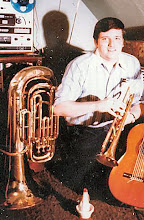
1963 Coral Records CRL 7-98123 Stereo 7" 33 1/3 RPM EP
Note, the cover used for this EP doesn't have the right catalog number or songs listed. It is the standard cover printed for the LP. The back cover is blank. This EP was used in juke boxes. Liner notes are excerpts from the LP.
Side One
1. I Want To Be Happy
2. Rockin' Chair
3. Ballin' The Jack
Side Two
1. Makin' Whoopee
2. Swing Low
3. Midnight Boogie
Liner Notes:
Several years ago, in an interview for his first album (Coral 57282, Pete Fountain's New Orleans) Pete Fountain remarked: "There's still quite a bit of jazz in New Orleans, you know. In proportion, we probably have more than you have in New York City...On Bourbon Street alone, there's seven Dixieland bands. Plus me. You know, me and the rhythm. We just swing away."
As far as anyone can tell from the confused mass of evidence that has come to light in the comparatively short time span since the historians began to investigate the subject, musicians have been swinging away on Bourbon Street, or in other sections of the Crescent City, since some-time before the turn of the century. In the early days, according to the veteran guitarist Danny Barker, "there were countless places of enjoyment that employed musicians, not including private affairs, balls, soirees, marriages, banquets, deaths, christenings, Catholic communions, confirmations, picnics at the lake front, country hay rides, and advertisements of business concerns. During the carnival season (Mardi Gras) any little insignificant affair was sure to have some kind of music, and each section would engage their neighborhood favorite." (Quote from "Hear Me Talkin' To Ya" by Shapiro & Hentoff.)
If there was music around the clock, certainly the quantity and quality of the performances was never higher than around midnight, an hour when citizens employed in the less glamorous jobs were free to enjoy the services of those nightlifers who were hired to entertain them.
Though some of the nostalgic glitter of New Orleans in the late nineteenth and early twentieth century may have worn thin, or at least may have abandoned its perpetual-motion schedule, the night hours in the 1960s are no less active than they were, say, in 1900, when some say jazz was born, or in 1930, when the Fountain family says Pete was born. The music still assumes a variety of forms: at times it has the rowdy, unconfined battle spirit of traditional Dixieland jazz, while in gentler moments it can assume the coloration of the more sophisticated, easily swinging music that grew to maturity during Pete Fountain's childhood.
It is the latter mood that is established on the first band of this album and maintained through-out these two thoroughly musical and consistently listenable sides.
The musicians are all familiar inhabitants of earlier Fountain packages: Bobby Gibbons on guitar, Jack Sperling on drums (replaced on Rockin' Chair, Morty Corb on bass, and from time to time Pete's perennial sidekick Godfrey Hirsch on vibes. The pianist is Midnight Boogie, and Stan Wrightsman on all the other bands. Arrangements by Bud Dant.
Vincent Youmans' I Want To Be Happy was composed and recorded six years before Fountain was born. It is an essentially simple melody that lends itself as ideally to a bright swinging interpretation as the Ellington theme is suited to the blues. Note Pete's effective use of syncopation, the well-conceived half-chorus solos of Wrightsman and Hirsch, and the ebullient spirit in which Pete rides it out.
Hoagy Carmichael's Rockin' Chair, one of the Hoosier songwriter's earliest successes (he and Louis Armstrong sang it as a duet on a 1929 record) is outlined with a suggestion of shuffle rhythm. Morty Corb's firmly walking bass behind Stan Wrightsman's solo is a conspicuously valuable component.
Ballin' The Jack is exactly a half century old. The Fountain rejuvenation is essentially swing music, with a moderately paced and keenly sustained rhythmic continuity. The impeccable Jack Sperling, in his breaks, never allows the listener to lose track of the beat.
Makin' Whoopee, a Gus Kahn song of 1928, opens with a Fountain chorus, splits one between piano and vibes, then returns it to Pete, all with a minimum of
complexity and often with a touch of the blues.
Swing Low is tastefully handled with a gospel feeling and occasional use of chimes, the latter alternating with piano in the second chorus. According to historian Sigmund Spaeth, this melody was "borrowed" by Dvorak for his New World Symphony.
The side concludes with an original by Fountain and Bud Dant, Midnight Boogie, in which shuffle-rhythm boogie-woogie alternates with straight-forward swinging ad lib blues.
You will have to do a lot of reconnoitering before you find happier or more relaxed music than this in New Orleans At Midnight.
- LEONARD FEATHER
Cover Photo: Hal Buksbaum


No comments:
Post a Comment